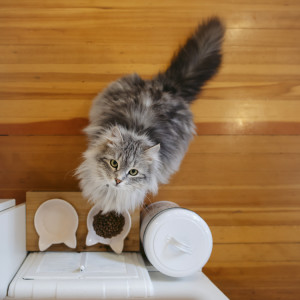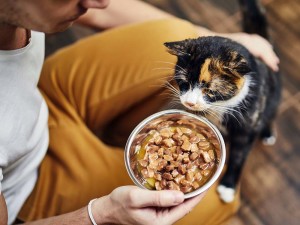Feline Foodies
From umami to kokumi, new research proves cats have pretty discerning palates.

share article
Any cat owner will be familiar with the challenges of trying to entice their pet to tuck into their foodopens in a new tab, which has earned cats the credentials of being very finicky creaturesopens in a new tab. Whilst frustrating to the pet owner, it is also fascinating to sensory scientists. Pickiness raises all kinds of questions: Why are cats so fussy? What flavors do they find irresistible? What can they smell? What are they tasting?
And as pet food manufacturers look to find more environmentally friendly ways to ensure the right balance of nutrients for our much-loved household favorites, how do we find tasty, nutritious and sustainable solutions?
What Do Cats Taste?
The best place to start is...thousands of years ago. Today’s domesticated cats took a very different evolutionary path than us. Cats are obligate carnivoresopens in a new tab, which means that their natural diet is composed entirely of meat. Their predatory hunting behavioropens in a new tab still shines through in our pets today. Humans, on the other hand, are omnivores. We can eat a varied diet of plants and or meat. (Dogs are also omnivores, which reflects their food scavenging behavior.) This is important, as it also helps to explain why cats’ taste perception has evolved differently to ours.
What Does “Taste Perception” Mean?
Imagine this: You are sitting with a group of friends in the park enjoying a picnic. While you are all in the same space and exposed to the same environment, each person’s perception of what they see, hear, feel, smell and taste will be different. That is because light, sound, touch, smell, and taste are all interpretations that our brains apply to a sensory input that originates from specialized receptor cells in our bodies.
A common example of these is red/green color blindness. We are individual in our interpretation of our environment, but differences are even greater across different animal species. To help us understand this, sensory scientists can compare responses and also delve in the DNA sequence. From this, we can start to build a picture of what another animal experiences, or perceives, from different taste compounds.
How Do Cats’ Tastes Differ From Humans?
Cats can’t taste “sweet.”
This is because they don’t have a functional sweet taste receptor, a finding from research opens in a new tabthat Waltham published in 2005. It makes sense if you think about it: meat doesn’t really taste sweet and it doesn’t have high amounts of sweet-tasting compounds, so a strict carnivore wouldn’t really have that much use for this taste receptor.
Cats love umami.
Although lacking the ability to cherish sweet flavors, cats have a much greater perception of umami-tasting compounds. Umami is the fifth basic element of taste. It has been used in Asian cuisine for centuries and is best described as the “meaty” or “savory” taste sensation. Tomatoes, mushrooms, and parmigiana cheese are all examples of foods we enjoy that have umami taste.
For cats, umami is thought to be the main driver of food preference, much like sweetness is for us as omnivores. In fact, cats have developed a much broader sense of umami taste than humans. With this, cats are able to detect more types of amino acids. These are the essential building blocks of proteins and are abundant in meat. Cats are more likely to enjoy eating meat-rich products, and it is possible that meat has a more complex and variable taste for cats than us.
New Research on Kokumi In Cats
Despite being an established and widely-accepted taste in Asian cuisine, kokumi is not (yet) widely known in our Western kitchens. This taste modality is often classed more as an enhancer, rather than a taste on its own. Paired with umami compounds, kokumi tasting-molecules are described as adding “mouthfulness” or “heartiness,” but on their own don’t taste much like anything. This makes it quite complicated to study, especially in animals who can’t exactly describe the “mouthfulness” of a dish.
My team at Waltham recently published research into understanding kokumi in catsopens in a new tab. To start with, our work was around identifying the kokumi taste receptor on the tongue of these pets. We managed to identify these receptors on cat taste papillae (nodules on the tongue) with the help and expertise of the molecular biologist in our team. We were able to construct three-dimensional models of the receptor based on its protein sequence; our partners at IMAX Discovery GmbHopens in a new tab set to work screening the molecules we identified in their laboratory, and we were able to further narrow down the number of potential compounds of interest and take them forward to the next stage — seeing what the cats think about them in a taste test.
The potential kokumi molecules were offered to the cat and human taste test panels on their own (dissolved in water), and then combined with some umami-active compounds. With human assessors, we can ask which samples taste different, as well as use descriptions. In cats, we need to get a bit more creative. We chose to use a preference test, where the cats are presented with a choice of two bowls, a different sample in each. These are either a simple taste compound dissolved in water, a mixture of these, or just water. This allows us to compare how much of each the cats drink and infer their preference.
In the end, we found important similarities in how the kokumi receptor works in people and cats, but differences in the taste preferences or perception. Kokumi seems to be an important taste modality for cats (and carnivores in general). It can help them detect the presence of essential compounds in meat, which means they will have an innate preference for foods that are highly nutritious for them. It is also another example of how food doesn’t taste the same to cats as it does to us.
Why Should We Care What Cats Can Taste?
My team at Waltham Petcare Science Instituteopens in a new tab is fascinated by trying to understand more about the flavors that cats and dogs enjoy. We love pets, and without tasty pet foods, the expertise and science that goes into creating nutritionally balanced meals won’t fulfill its purpose in keeping cats healthy.
Also, if cats devour their daily meals, there is less waste from leftovers. As we constantly strive to reduce our environmental footprint at Mars Petcareopens in a new tab, we are also looking at how we can create tasty pet food that is also sustainable through new products, such as Lovebugopens in a new tab, which is made from insects.

Dr. Anni Laffitte, PhD
Anni Laffitte, PhD, is a Specialist Research Scientist working in sensory science at Waltham Petcare Science Institute in the UK. Waltham is the global science centre for Mars Petcare. Anni has a PhD in Biochemistry and Food Science, and has been working on understanding human and animal taste perception for nearly ten years. Although she doesn't have a pet of her own for now, she loves to cuddle friends’ and family’s pets at every possible occasion. In her free time she enjoys spending time with her family, knitting, travelling and reading.
Related articles
![A fluffy cat looking up next to a food dish.]() opens in a new tab
opens in a new tab“Freeloading” Cats Won’t Work for Food
Cats prefer to be served, study says.
![Profile view of a man giving a cat food to eat]() opens in a new tab
opens in a new tabWhy Is My Cat Not Eating? Causes, Symptoms, and Treatment
A veterinary nutritionist explains why your cat isn’t eating and how to increase their appetite.
![Senior cat looking at a bowl of wet food while its owner kneels next to it and pets its back]() opens in a new tab
opens in a new tabFinally, the Reason Why Your Cat Is a Picky Eater
A new study reveals a quick fix for your senior cat’s loss of appetite.
![Hand holding food bowl peeks into frame as a cat looks up expectantly]() opens in a new tab
opens in a new tabThe Ultimate Puzzle: Picking the Right Cat Food
Four veterinary nutritionists pick apart the claims so that you can choose the right food for your kitty.



